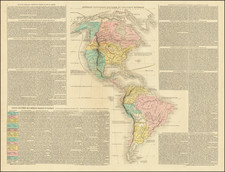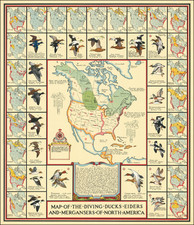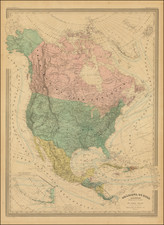Rare English edition of Philippe Buache's important map of North America ( Carte Mineralogique ou l'on voit la Nature des Terreins du Canada et du Louisane . . . 1752), generally regarded as the first geological map of the continent (which was not actually published until 1756).
Cole's map appeard in the December 1756 edition of the Literary Magazine, a short-lived British periodical published by Dr. Samuel Johnson from 1756 to 1758. The map is a relatively faithful copy of Buache's rare and highly important map, which accompanied Jean-Etienne Guettard's Memoires de l'Academie royale des sciences . . . As noted by Gregory Good in Sciences of the Earth . . ., Vol. 1 (p. 303) "perhaps the most important geological maps of the 1700s were those by Jean-Etienne Guettard (1715-1786), in association with Philippe Buache . . . "
The map includes 39 symbols to show the locations of rocks, minerals, springs, and fossils between the Atlantic and the Rocky Mountains. The primary difference between the two maps is the ommission of the inset map of the Gulf of St. Lawrence map, which appeared on Buache's map. As noted in the Canadian Mineralogist (Special Publication #6), p.7:
Efforts to portray on a map the geology of what is now the United States extend back more than two centuries. The first recorded attempt is a "Mineralogic map, showing the nature of the terrains of Canada and Louisiana" ("Carte minéralogique où l'on voit la nature des terrains du Canada et de la Louisiane"), by the French geologist Jean-Étienne Guettard, published in 1752, at a time when a large part of the region was still French territory. Whether he visited North America is not certain, and most of his information was compiled from reports of French officers. A belt of marl and clay is shown extending from the Gulf of Mexico to Cape Breton Island, and thence inland toward Quebec. Between it and the coast is a sandy belt, and west of it a schistose and metalliferous belt. Different signs and annotations indicate the places where rocks and minerals were reported between the Atlantic Coast and the Rocky Mountains. Aside from this primitive effort, the first geologic map of the United States is that published by William Maclure in 1809, of which a revised version appeared in 1817. [J'ai perdu les références de cette notice. (B.G.)]
Among the other curious features, the map is one of the earliest English depictions of the Sea of the West (Western Sea). The map is extremely rare (perhaps even unknown to the above writer). This is the first example of the map which we have ever seen on the market, either separately or bound with the text. We have been unable to locate any institutional copy of the map.










![[French America and the Triangular Trade] L'Amérique Françoise Où son Décrites La France Nouvelle, La France Insulaire, La France Equinoctiale, et autre pais Par P. Du Val d'Abbeville Geographe du Roy . . .](https://storage.googleapis.com/raremaps/img/small/91968.jpg)



![[United States Independence After The Revolution] A New Map of North America, with the West India Islands, Divided according to the Preliminary Articles of Peace, Signed at Versailles, 20 Jan. 1783, wherein are particularly Distinguished The United States, and the Several Provinces, Governments &ca, which Compose the British Dominions . . . 1783](https://storage.googleapis.com/raremaps/img/small/70734.jpg)